Photo: Paul Rudderow
Since he took over as the Philadelphia Union’s head man, one consistent criticism of John Hackworth is that he can be tactically naive. The 2013 Union midfield invited deep pressure on a first year center back pairing and a young goalie. The opposition’s halftime adjustments were often met with no response until Antoine Hoppenot was reliably introduced after 60 minutes.
So let’s start with a positive: Hackworth has gotten his tactics spot on this season. Against Portland and New England, Philadelphia came out with a game plan and an understanding of how to execute it. Chalk this up to new, better personnel if you like. But those new guys aren’t playing alone: Everyone comes out on the same page.
And after forty-five minutes of watching the Union pass the ball around his five-man midfield with unencumbered ease, New England coach Jay Heaps had to make changes. What appeared to be a shift from a 4-5-1 to a 4-4-2 turned out to be a much more interesting tactical adjustment with a surprisingly pointed aim. Striker Jerry Bengston came on for the Donald Smith (though I’m not convinced Smith was ever actually on the field), and the move facilitated an immediate change in the flow of the game. New England was able to exert pressure in midfield and on the Union’s back line, and the home side rarely threatened from then on.
Faking the 4-4-2
Jerry Bengston is a striker. He was subbed on for a midfielder. Clear giveaway that a team is changing it’s shape, right?
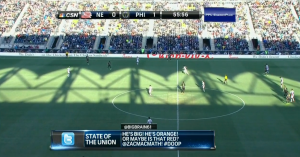
56th minute: Bengston sits between the center backs while Nguyen stays central near Edu and the free man steps to Nogueira.
Nope. In fact, the substitution was a workaround to get Diego Fagundez back to the left side of the field. Playing on the right, Fagundez was occupying the same space striker Teal Bunbury wanted. So when Bengston came on, Fagundez moved to the left and Bunbury dropped into a right winger role. Bengston took Bunbury’s role up top, but instead of trying to run in behind the defense, he began challenging Austin Berry in the air.
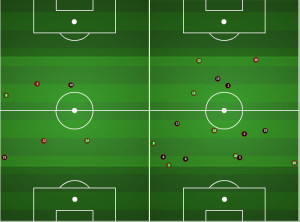
New England tackles and interceptions (in the middle third) in the first half (L) and second half (R)
Additionally, Lee Nguyen stepped slightly deeper into the midfield to pick up Nogueira and Edu. Nguyen had spent the first half ball hunting with Bunbury when the Union were in possession, often getting caught too far upfield. In the second half, he held a slightly deeper position while Bengston actively attempted to separate the two centerbacks, forcing the Union to pick a side before Nguyen joined the pressure.
The effect was immediate. New England was able to exert pressure high up the pitch and break up the Union’s possession game.
Putting the back in fullback
The second benefit the Revs reaped from Heaps’ halftime adjustment was more subtle, and it speaks volumes for the New England coach that he was able to target a major issue so successfully.
In the first half, the Union fullbacks were rampant. According to the OPTA-powered Chalkboard, Fabinho completed 19 of 25 passes on the left and Gaddis added a freakish 34 of 43 on the right. Flipping the old adage on its head, Heaps decided that the best defense was a good offense. Or he just tried to psyche the Union out… and it worked.
One of the keys to Philly’s first half surge was Gaddis’ involvement higher up the pitch. While Fabinho remained deeper and attempted longer passes, Gaddis was intimately involved with Nogueira and Maidana, giving an outlet when needed and playing a compact game whenever possible. It was a confident half from a player that can appear indecisive when in possession. With Fagundez nearby, Gaddis was much more hesitant to get forward in the second half. And who can blame him? Kelyn Rowe was on the bench, which made Fagundez every bit as important to the Revolution offense as Nogueira is to the Union’s attack.
Fagundez was no superstar in the second half, but by dangling him in front of Gaddis, Heaps cut out the wide outlet the Union had used to great effect in the first forty-five. Unfortunately, John Hackworth did not adjust by asking his wingers to play a bit deeper to facilitate possession; Le Toux remained upfield.
Meanwhile, Bunbury labored on the wing. Largely isolated, he challenged Fabinho on the dribble with moderate success (2/6 take-ons). On the whole, though, Bunbury was a much more disciplined defender than Donald Smith. He stayed at home and pressured vertically, taking away the width Nogueira enjoyed throughout the first half.
Riding the Leo Grande
The final piece of the puzzle for New England was closing down Leo Fernandes. PSP’s Player of the Week from Jeremy Lane on Fernandes provides a good description of how influential the second year player was in the first half of this match.
On Thursday, we will break down exactly how Fernandes picked apart the New England formation in the first half and how Heaps and the Revs adjusted to make the Union midfielder more one-dimensional in the latter half of the match.
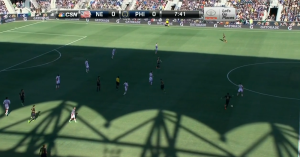
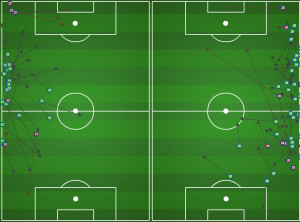
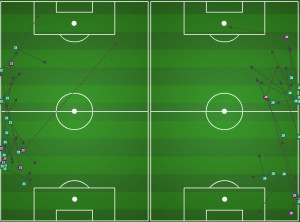
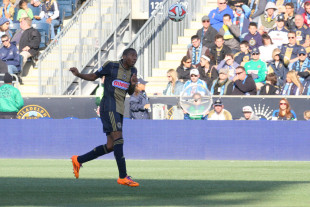

Another factor was that both Berry and Fabinho were playing hurt in the second half. After Wheeler came in the Revolution attack really fizzled (though Wheeler’s distribution was poor).
And Fabinho looked to be in real trouble. He managed his injury well but that took away his offensive threat for much of the half.
I have no info on how injured Fabinho really was, but when he had space to get forward he looked pretty healthy. Let’s hope he’s 100% against Columbus.
This is a great opening to ask a question that came to mind Saturday after Fabinho was down hurt in the box. If he had to come off, who would’ve play LB? My best guess would be Gaddis to the left and Le Toux to the right. Was there another option available?
in watching the rebroadcast the other night, Fab was limping in the 15th minute (or close to it). that guy’s a fighter.
interesting read, thanks for posting this
Nice analysis of Heaps’ tactics, but I disagree on one point. I don’t know if it would have been best for Hack to adjust his tactics based on Heaps’ changes. That kind of reactionary gameplan has spoiled us in the past. Instead, the players on the pitch need to recognize that Ray and Leo have been shut down, and shift the attack to others (like Fabinho and Maidana) who need to exploit the open space.
.
Sometimes I think we overestimate the role a manager has during the game. Ultimately it’s the players on the pitch that make the game-changing difference. That’s why we love soccer so much more than American football.
Absolutely agree with you. I think an appropriate adjustment wouldn’t necessarily be changing things up, but using halftime and the subs to focus on what to do if New England upped their pressure. Regardless of what personnel changes Heaps made, the pressure was coming. Outlining an ideal “Plan B” and making sure everyone understands their role in it would be more along the lines of what I mean by “adjusting”.
Nothing against Gaddis, who played great on Saturday, but I can’t wait to see what Williams can add to the attack paired with the new midfield.
Soooo what you’re saying is Heaps makes in game adjustments and Han still can’t seem to do that?